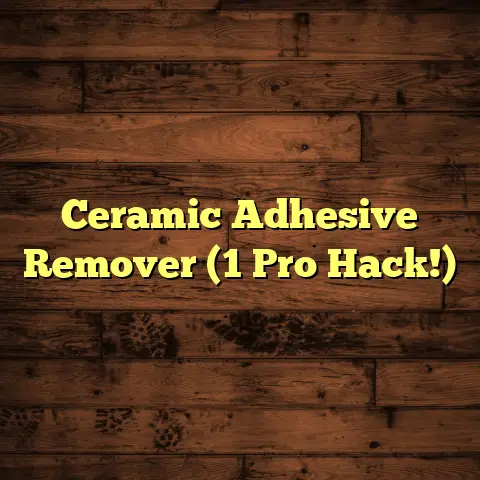Shower Drain in Concrete? (5 Steps, Do or Don’t!)
Ever stepped into your shower and felt like you’re ankle-deep in a mini-pool? Or maybe you’ve noticed a funky smell lingering around your bathroom, no matter how much you clean?
Chances are, your shower drain is trying to tell you something. As a flooring contractor with years of experience, I’ve seen firsthand the havoc a neglected shower drain can wreak, especially when it’s set in concrete.
Moisture, heavy usage, and the unyielding nature of concrete can create a perfect storm of problems – clogs, leaks, and even structural damage.
That’s why understanding how to install or repair a shower drain in a concrete floor is crucial. It’s not just about convenience; it’s about protecting your home from costly damage.
So, should you tackle this project yourself, or call in a pro? Let’s dive into the nitty-gritty with these 5 steps to help you decide!
Section 1: Understanding the Importance of a Proper Shower Drain
Let’s face it, the shower drain isn’t exactly the sexiest part of your bathroom. But trust me, it’s one of the most important.
Think of it as the unsung hero, silently whisking away water and preventing your shower from turning into a swamp.
Why is a proper shower drain so important?
-
Prevents Water Accumulation: This one’s obvious, right? A functioning drain keeps water from pooling in your shower, which can be a slipping hazard and just plain gross.
-
Maintains Hygiene: Standing water is a breeding ground for bacteria and mold. A good drain gets rid of that water, keeping your shower clean and healthy.
-
Protects Your Home: Improper drainage can lead to water seeping into your walls and floors, causing mold growth, wood rot, and even structural damage to the concrete.
I’ve seen bathrooms where neglected shower drains have led to thousands of dollars in repairs. Believe me, a little preventative maintenance goes a long way!
What happens when drainage goes wrong?
-
Mold Growth: Dark, damp environments are mold’s happy place. And a leaky shower drain creates the perfect conditions for it to thrive.
-
Water Damage: Water can seep into the subfloor, walls, and even the rooms below your bathroom, causing extensive damage.
-
Concrete Deterioration: Water can penetrate the concrete, causing it to crack and crumble over time. This can compromise the structural integrity of your shower.
Signs of a Faulty Shower Drain
How do you know if your shower drain is crying out for help? Here are some telltale signs:
-
Slow Drainage: If your shower water takes forever to drain, it’s a clear indication of a clog or blockage.
-
Unpleasant Odors: That musty, mildewy smell? It’s likely coming from bacteria and mold growing in your drain.
-
Visible Water Pooling: If you see water pooling around your drain, it means the drain isn’t doing its job properly.
-
Gurgling Sounds: Strange gurgling noises coming from your drain can indicate a blockage in the drainpipe.
-
Cracked or Damaged Drain Cover: A damaged drain cover can be a sign of underlying problems with the drain itself.
I remember one client who ignored a slow-draining shower for months. By the time they called me, the water had seeped into the subfloor, causing extensive mold growth and requiring a complete bathroom remodel. Don’t let that happen to you!
Section 2: Step 1 – Assessing the Existing Drainage System
Okay, so you suspect your shower drain might be on the fritz. What’s the first step? Assessing the situation, of course!
Think of yourself as a plumbing detective, gathering clues to determine the extent of the problem.
Evaluating the Current Setup
-
Check for Clogs and Debris: This is the easiest place to start. Remove the drain cover and shine a flashlight down the drain. Do you see any hair, soap scum, or other debris?
Sometimes, a simple clog is all that’s causing the problem. You can try using a drain snake or a bent wire hanger to remove the blockage.
-
Inspect the Drain Cover and Flange: Look for cracks, rust, or other damage to the drain cover and the flange (the part that sits flush with the shower floor).
If the flange is cracked or corroded, it may need to be replaced.
-
Check for Leaks: Turn on the shower and let the water run for a few minutes. Then, check around the drain for any signs of leaks.
Pay close attention to the area where the drain meets the concrete floor.
Identifying the Type of Drain
There are several different types of shower drains, each with its own pros and cons. Knowing what type you have will help you determine the best course of action.
-
PVC Drains: These are the most common type of shower drain. They’re made of plastic and are relatively inexpensive and easy to install.
-
Cast Iron Drains: These are more durable than PVC drains, but they’re also heavier and more difficult to work with. Cast iron drains are often found in older homes.
-
Brass Drains: Brass drains are corrosion-resistant and can add a touch of elegance to your shower. However, they’re also more expensive than PVC drains.
-
Linear Drains: These are long, narrow drains that are typically installed along the edge of the shower. Linear drains are becoming increasingly popular in modern shower designs.
Repair or Replace?
Once you’ve assessed the situation, you need to decide whether to repair the existing drain or replace it altogether.
-
Repair: If the problem is a simple clog or a minor leak, you may be able to repair the drain without replacing it.
-
Replace: If the drain is severely damaged, corroded, or leaking, it’s usually best to replace it.
Replacing a shower drain in concrete can be a challenging project, so it’s important to weigh the pros and cons before making a decision.
I had one client who was convinced they could fix their leaky shower drain with some caulk. After several failed attempts, they finally called me. Turns out, the drainpipe was completely corroded and needed to be replaced.
Sometimes, it’s better to bite the bullet and call in a professional.
Section 3: Step 2 – Gathering Materials and Tools
Alright, you’ve assessed the situation and decided on a course of action. Now it’s time to gather your supplies.
Think of this as prepping your battlefield. You need to have all the right weapons and armor before you go into battle with that concrete floor!
Materials List
Here’s a comprehensive list of materials you might need, depending on whether you’re repairing or replacing your shower drain:
-
New Shower Drain: Choose a drain that’s compatible with your existing plumbing and shower design.
-
Drain Flange: If your existing flange is damaged, you’ll need to replace it.
-
Drain Gasket or Seal: This will create a watertight seal between the drain and the shower floor.
-
Plumber’s Putty: This is used to seal the drain flange to the drainpipe.
-
PVC Primer and Cement (if using PVC drain): This is used to connect PVC pipes and fittings.
-
Concrete Mix: This is used to patch any holes or cracks in the concrete floor.
-
Waterproof Membrane: This is applied to the concrete floor to prevent water from seeping into the subfloor.
-
Grout (if needed): This is used to fill the gaps between the tiles around the drain.
-
Caulk: This is used to seal the edges of the drain and prevent water from leaking.
Tools List
Here’s a list of tools you’ll need for the job:
-
Safety Glasses: Protect your eyes from flying debris.
-
Gloves: Protect your hands from chemicals and sharp edges.
-
Dust Mask: Protect your lungs from concrete dust.
-
Jackhammer or Rotary Hammer: This is used to break up the concrete around the old drain.
-
Chisel and Hammer: These are used to remove the old drain and clean up the concrete.
-
Plumbing Wrench: This is used to tighten and loosen plumbing fittings.
-
Pipe Cutter: This is used to cut PVC pipes to the correct length.
-
Level: This is used to ensure the drain is properly aligned.
-
Trowel: This is used to apply concrete mix and grout.
-
Caulk Gun: This is used to apply caulk.
-
Shop Vacuum: This is used to clean up dust and debris.
Choosing High-Quality Materials
Don’t skimp on materials! Investing in high-quality drains, sealants, and concrete mix will ensure durability and longevity.
I’ve seen too many homeowners try to save a few bucks by buying cheap materials, only to have their shower drains fail within a few years. It’s not worth it!
Section 4: Step 3 – Preparing the Concrete Floor
Okay, you’ve got your materials and tools. Now it’s time to get down and dirty with that concrete floor.
This is where things can get a little tricky, so pay close attention!
Removing the Old Drain
-
Turn Off the Water: Before you start, make sure to turn off the water supply to your shower.
-
Remove the Drain Cover: Use a screwdriver or pliers to remove the drain cover.
-
Break Up the Concrete: Using a jackhammer or rotary hammer, carefully break up the concrete around the old drain.
Be careful not to damage the drainpipe or the surrounding plumbing.
-
Remove the Old Drain: Once you’ve broken up the concrete, you should be able to remove the old drain.
You may need to use a chisel and hammer to loosen it.
Cutting Through Concrete
-
Mark the Area: Use a marker to outline the area you need to cut.
-
Cut the Concrete: Using a jackhammer or rotary hammer with a concrete cutting blade, carefully cut along the marked lines.
Take your time and be careful not to cut too deep.
-
Remove the Concrete: Once you’ve cut the concrete, you should be able to remove it with a chisel and hammer.
Safety Precautions
-
Wear Protective Gear: Always wear safety glasses, gloves, and a dust mask when working with concrete.
-
Ensure Proper Ventilation: Concrete dust can be harmful to your lungs, so make sure to work in a well-ventilated area.
-
Be Careful with Power Tools: Jackhammers and rotary hammers can be dangerous if used improperly. Read the manufacturer’s instructions carefully before using these tools.
Leveling the Surface
-
Clean the Area: Use a shop vacuum to clean up any dust and debris from the concrete floor.
-
Apply Concrete Mix: Mix the concrete mix according to the manufacturer’s instructions.
-
Level the Surface: Use a trowel to apply the concrete mix to the area around the drain. Make sure the surface is level and smooth.
Ensuring Proper Slope
-
Create a Slope: The shower floor should have a slight slope towards the drain to ensure proper drainage.
Use a level to check the slope and make sure it’s at least 1/4 inch per foot.
I once worked on a shower where the floor was completely flat. The water would just sit there, creating a breeding ground for mold and mildew. It was a mess!
Making sure you have the proper slope is crucial for a functional and healthy shower.
Section 5: Step 4 – Installing the New Shower Drain
Okay, the concrete is prepped and ready to go. Now it’s time for the main event: installing the new shower drain!
This is where your plumbing skills will be put to the test.
Step-by-Step Guide
-
Apply Plumber’s Putty: Roll a rope of plumber’s putty and place it around the underside of the drain flange.
-
Insert the Drain: Insert the new shower drain into the drainpipe.
-
Tighten the Drain: Use a plumbing wrench to tighten the drain securely.
Be careful not to overtighten, as this could damage the drain or the drainpipe.
-
Connect the Drainpipe: If you’re using a PVC drain, use PVC primer and cement to connect the drainpipe to the drain.
-
Seal the Drain: Apply a bead of caulk around the edge of the drain where it meets the shower floor.
Aligning with Existing Plumbing
-
Check the Alignment: Make sure the new drain is properly aligned with the existing plumbing.
You may need to adjust the drainpipe or the drain flange to get the alignment right.
-
Use Flexible Couplings: If the drainpipe is not perfectly aligned, you can use flexible couplings to connect it to the drain.
Sealing the Drain Properly
-
Use a High-Quality Sealant: Choose a sealant that’s specifically designed for use in showers.
-
Apply the Sealant Generously: Don’t be afraid to use plenty of sealant. It’s better to have too much than not enough.
-
Let the Sealant Cure: Allow the sealant to cure completely before using the shower.
Common Mistakes to Avoid
-
Insufficient Sealing: This is the most common mistake people make when installing shower drains. Make sure to use plenty of sealant and apply it properly.
-
Improper Slope: As I mentioned earlier, the shower floor needs to have a slight slope towards the drain to ensure proper drainage.
-
Overtightening the Drain: Overtightening the drain can damage the drain or the drainpipe.
-
Using the Wrong Materials: Make sure to use materials that are compatible with your existing plumbing and shower design.
I had one client who tried to install a shower drain without using any sealant. Needless to say, it leaked like a sieve!
Don’t make the same mistake. Sealing is key!
Section 6: Step 5 – Testing and Finishing Touches
You’ve installed the new shower drain. Now it’s time to test it out and put on the finishing touches.
Think of this as the final inspection. You want to make sure everything is working perfectly before you declare victory!
Testing for Functionality
-
Run Water Through the Drain: Turn on the shower and let the water run for a few minutes.
-
Check for Leaks: Carefully check around the drain for any signs of leaks.
-
Observe the Drainage: Make sure the water is draining properly and not pooling around the drain.
Finishing Touches
-
Seal the Surrounding Concrete: Apply a waterproof sealant to the concrete around the drain to prevent water from seeping into the subfloor.
-
Apply Grout (if needed): If you removed any tiles around the drain, apply grout to fill the gaps between the tiles.
-
Clean Up: Use a damp cloth to clean up any excess sealant or grout.
Regular Maintenance Checks
-
Clean the Drain Regularly: Remove the drain cover and clean out any hair, soap scum, or other debris that may be clogging the drain.
-
Check for Leaks: Periodically check around the drain for any signs of leaks.
-
Inspect the Sealant: Inspect the sealant around the drain for cracks or damage. If you see any, reapply the sealant.
I recommend cleaning your shower drain at least once a month to prevent clogs and maintain proper drainage.
A little preventative maintenance can save you a lot of headaches down the road.
Conclusion
So, there you have it – a comprehensive guide to installing or repairing a shower drain in concrete.
Remember, a properly functioning shower drain is essential for preventing water damage, mold growth, and other costly problems.
By following these five steps, you can significantly reduce the risk of wear-and-tear-related issues and ensure a more functional and long-lasting shower area.
But here’s the million-dollar question: should you DIY this project, or call in a pro?
If you’re comfortable working with power tools, have some plumbing experience, and are confident in your ability to follow instructions, then DIY might be a good option for you.
However, if you’re not comfortable with any of these things, or if you’re dealing with a complex plumbing issue, it’s always best to call in a professional.
A professional plumber will have the knowledge, skills, and experience to get the job done right, and they can also identify and address any underlying plumbing problems that you might not be aware of.
Ultimately, the decision is yours. Just remember to weigh the pros and cons carefully before making a decision.
No matter what you decide, I hope this article has been helpful. Now go forth and conquer that shower drain!




